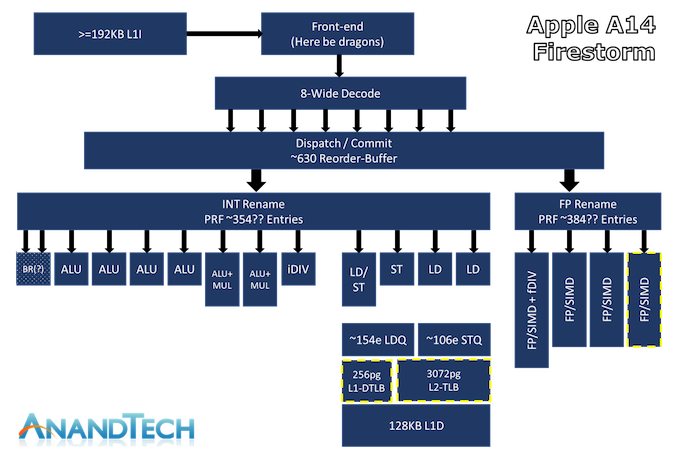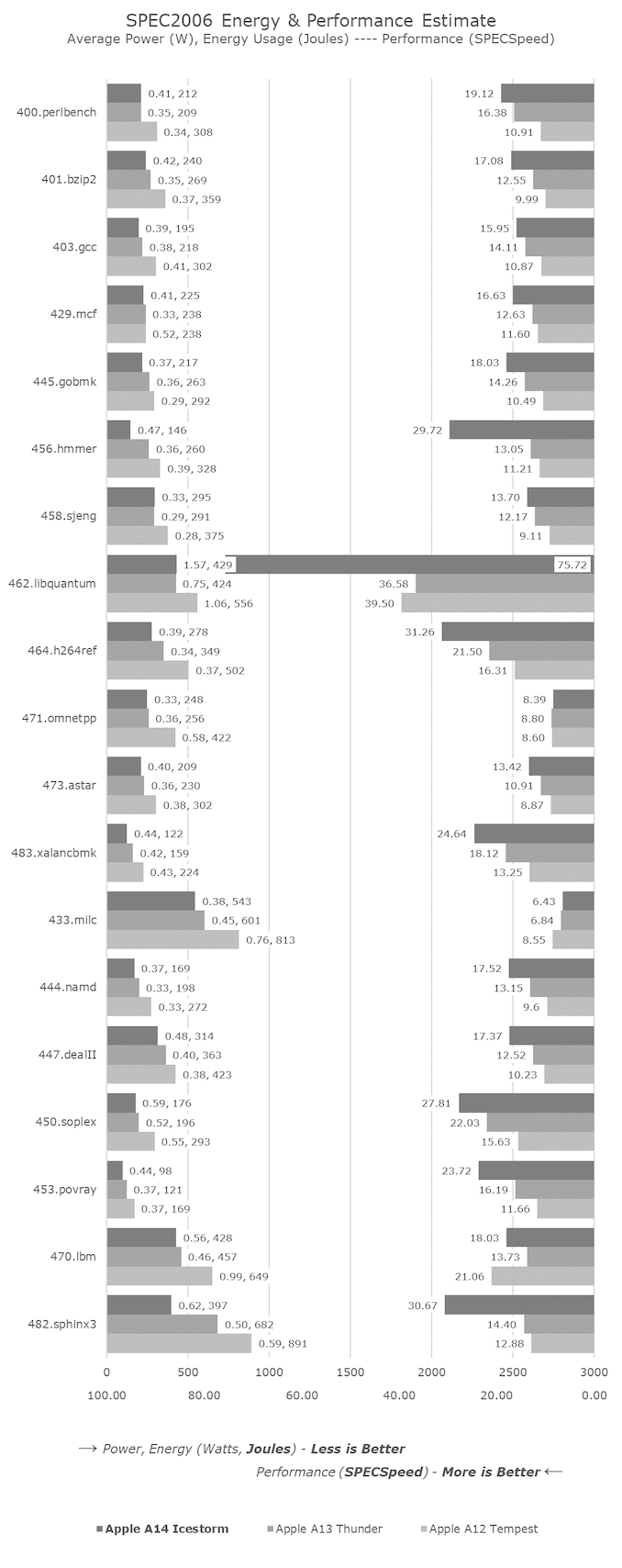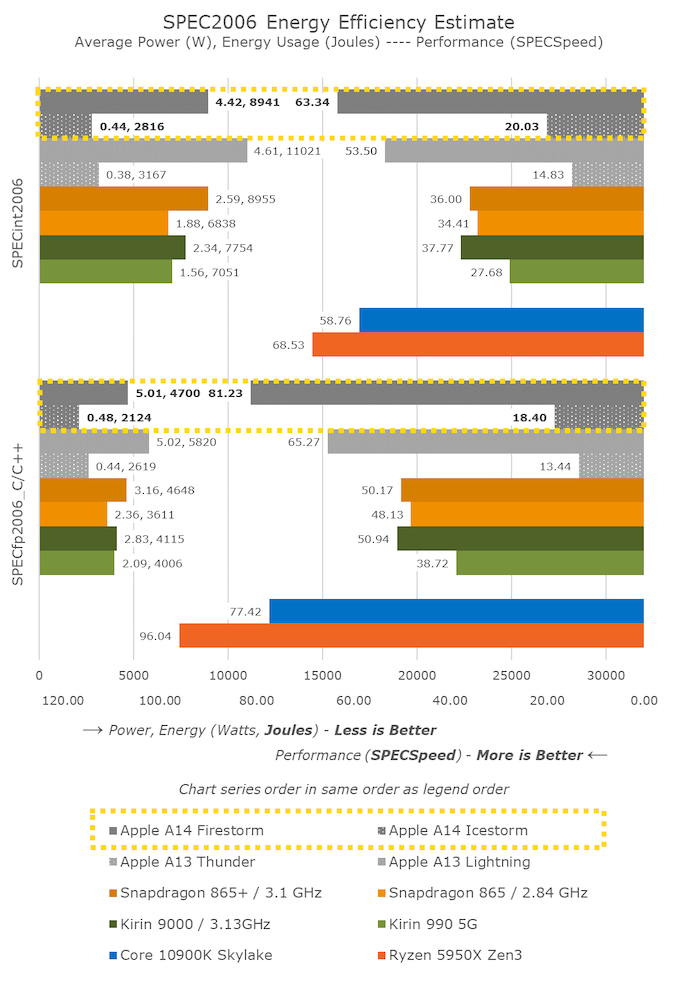The iPhone 12 & 12 Pro Review: New Design and Diminishing Returns
by Andrei Frumusanu on November 30, 2020 8:30 AM EST- Posted in
- Mobile
- Apple
- Smartphones
- Apple A14
- iPhone 12
- iPhone 12 Pro
The Apple A14 SoC: Firestorm & Icestorm
The new Apple A14 is the company’s newest mobile SoC and sits at the heart of the new iPhone 12 series. The new chip is the industry’s first commercial 5nm manufactured chip from TSMC, alongside the now no longer manufactured Kirin 9000.
Inside the A14 we find two big performance cores dubbed “Firestorm” and four efficiency cores called “Icestorm”, making this a 2+4 heterogeneous CPU SoC. Alongside the CPUs, we also find a 4-core GPU. Unfortunately this year it seems like we haven’t seen a public die shot of the A14, though Apple themselves published a shot of the M1 during their announcement event.
| Maximum Frequency vs Loaded Threads Per-Core Maximum MHz |
||||||
| Apple A13 | 1 | 2 | 3 | 4 | 5 | 6 |
| Performance 1 | 2666 | 2590 | 2590 | 2590 | 2590 | 2590 |
| Performance 2 | 2590 | 2590 | 2590 | 2590 | 2590 | |
| Efficiency 1 | 1728 | 1728 | 1728 | 1728 | ||
| Efficiency 2 | 1728 | 1728 | 1728 | |||
| Efficiency 3 | 1728 | 1728 | ||||
| Efficiency 4 | 1728 | |||||
| Apple A14 | 1 | 2 | 3 | 4 | 5 | 6 |
| Performance 1 | 2998 | 2890 | 2890 | 2890 | 2890 | 2890 |
| Performance 2 | 2890 | 2890 | 2890 | 2890 | 2890 | |
| Efficiency 1 | 1823 | 1823 | 1823 | 1823 | ||
| Efficiency 2 | 1823 | 1823 | 1823 | |||
| Efficiency 3 | 1823 | 1823 | ||||
| Efficiency 4 | 1823 | |||||
The new A14 raises the clock speeds of the CPU by a good amount, now essentially reaching 3GHz on the large performance cores in single-threaded scenarios. Once a second big cores come on this reduces to 2.89GHz and stays there even in heavier multi-threaded workloads. The efficiency cores land in at 1823MHz now, roughly a 100MHz boost over the A13, but we do know that in power unconstrained scenarios they can reach quite higher, such as 2064MHz employed on the M1.
The summary is that in this generation, Apple progresses the design further and making it wider than before, increasing the ROB size from 560 to 630, having significantly larger L1 DTLB which has now doubled in size from 128 pages to 256 pages, and increasing the L2 TLB from 2048 pages to 3072 pages. It’s particularly on the part of the floating point and vector execution units where the new Firestorm cores saw most of the design changes this year through the introduction of a 4th pipeline unit, essentially increasing the execution capabilities of this part of the design by 33%. On the integer side of the CPU, things have remained relatively the same with only minor changes, and the Firestorm cores continue on with the sale 192KB L1 I-cache and 128 L1 D-cache and 8MB of shared L2 amongst the two cores.
What we didn’t cover in more detail in the M1 piece was the new small efficiency cores. The Icestorm design is actually a quite major leap for Apple as it sees the introduction of a third integer ALU pipeline, and a full second FP/SIMD pipeline, vastly increasing the execution capabilities of this core. At this point it would be wrong to call it a “small” core anymore as it now essentially matches the big core designs from Arm from a few years ago, being similar in complexity as an A75.
Looking at the generational improvements of the efficiency cores we can see that Apple is indeed showcasing performance increases beyond that of just the increased 100MHz of the cores, with substantial upgrades across the workload spectrum.
Especially the floating-point workloads of the SPEC suite see very large improvements, exactly in the tests which are more execution heavy such as 453.povray or 482.sphinx3.
Apple still continues to limit the absolute performance of the efficiency cores when they are the only allowing the memory controller to not scale up to a higher frequency, meaning that the scores here in isolation are posting worse performance than in a normal more varied real-world scenario where the big CPU cores or the GPU would also be active, hence the scores aren’t directly comparable to other measurements we’ve made.
Overall, the new A14 is massively impressive and grows the performance gap compared to the competition. Apple has now reached higher single-threaded performance within their phone SoCs than what Intel can deliver in any of their designs, whilst only losing out to the desktop variants of AMD’s new Zen3 processors.
What’s important to note here is that Apple’s performance increase this generation did not come at a cost of increased power consumption, as the designers were able to leverage the microarchitectural improvements and the new process node – actually reaching either power parity or a small power reduction compared to the 7nm based A13. This means that the performance increases this generation also results in an energy efficiency increase for the design, with the A14 using notably less energy to complete a workload.
I’ve included the efficiency cores in the chart here to showcase that they’re not weak at all. The performance showcased here roughly matches a 2.2GHz Cortex-A76 which is essentially 4x faster than the performance of any other mobile SoC today which relies on Cortex-A55 cores, all while using roughly the same amount of system power and having 3x the power efficiency.













101 Comments
View All Comments
iphonebestgamephone - Tuesday, December 1, 2020 - link
Ah the realme x, the gold standard of all budget phones with a flagship soc.RSAUser - Tuesday, December 1, 2020 - link
That mini is making me quite tempted to move over, been looking for a good small phone to upgrade to since Samsung dropped continuing the S10e line.eastcoast_pete - Tuesday, December 1, 2020 - link
Just out of curiosity: can you record in 4K60p with Dolby until the storage or the battery runs out, or does the iPhone 12 go into thermal shutdown like so many "action cams"? I know this is a niche question, but maybe you, Andrei, or someone else here has tried it?Bob Todd - Tuesday, December 1, 2020 - link
I just did a quick test for you, 30 minutes of 4k60 with Dolby Vision on. No thermal issues here on a 12 Mini.HalideRadar - Monday, January 4, 2021 - link
iPhone 12 mini doesn’t support Dolby Vision at 4K60, only up to 4K30zepi - Tuesday, December 1, 2020 - link
Any hope for 12 pro max camera test?radoslavp - Tuesday, December 1, 2020 - link
I'm really puzzled by what is happening.All reviews on the Internet say how great the battery life of Iphone 12 series is, however in the mean time there are thousands of owners who complain about ridiculously bad battery - drain, 5G battery issues all over the place, yet no one is publicly speaking about it.
I will share just one link: https://discussions.apple.com/thread/251956914
If you type "iphone 12 battery" in google you will end up with countless complains ........ yet not a single line with all reviewers.
Strange isn't it?
Bob Todd - Tuesday, December 1, 2020 - link
Basically every smart phone released since forever has quite a few threads about battery drain problems from some users. You also need to take into account the population size here. I'm sure Apple has sold more than a million units across the range already. My anecdotal rebuttal to anecdotal accounts of problems is that my 12 Mini with the smallest battery has surprised me with how good the battery life is. I skipped charging it a few nights ago and went to sleep with 62%. In the morning it was down to 56%. No low power mode, no turning off any radios, and it was losing less than 1%/hour at idle with all the usual suspects like multiple Gmail accounts, an Exchange account, Facebook etc. setup. Just before midnight the next night it was down to 10%. TL;DR: I think they can all make it through a day of "average" use easily.PickUrPoison - Saturday, December 12, 2020 - link
There are definitely some 5G issues with this switch to a new modem/radio. I’d think that between Apple and Qualcomm they have enough engineering resources to dial it in.theblitz707 - Tuesday, December 1, 2020 - link
its a shame you guys dont test minimum brightness anymore :( Im very interested in black clipping